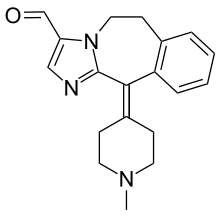Alcaftadine
Alcaftadine is used to prevent eye irritation brought on by allergic conjunctivitis. It is a H1 histamine receptor antagonist.[1]
 | |
| Clinical data | |
|---|---|
| AHFS/Drugs.com | Consumer Drug Information |
| MedlinePlus | a611022 |
| License data | |
| Pregnancy category |
|
| Routes of administration | Topical |
| ATC code | |
| Legal status | |
| Legal status |
|
| Pharmacokinetic data | |
| Elimination half-life | ~2 hrs |
| Identifiers | |
IUPAC name
| |
| CAS Number | |
| PubChem CID | |
| IUPHAR/BPS | |
| DrugBank | |
| ChemSpider | |
| UNII | |
| KEGG | |
| ChEBI | |
| ChEMBL | |
| CompTox Dashboard (EPA) | |
| Chemical and physical data | |
| Formula | C19H21N3O |
| Molar mass | 307.397 g·mol−1 |
| 3D model (JSmol) | |
SMILES
| |
InChI
| |
| | |
It was approved by the U.S. Food and Drug Administration in 2010 under the trade name Lastacaft.
Pharmacology
Alcaftadine is an antagonist at three of the histamine receptors (1, 2 and 4). The main indication for Alcaftadine is for prevention of allergic conjunctivitis. By blocking these three receptors, Alcaftadine has been shown to significantly reduce the effects of allergens. This effect on histamine receptors seems to show lower rates of itching, eosinophil recruitment and redness after exposure to an allergen.[2] The effect of alcaftadine seemed to reduce the amount of eosinophil cells significantly as compared to olopatadine 0.1%. When animal models were used to test alcaftadine, alcaftadine 0.25% seemed to show superior results for decreasing E-cadherin expression as compared to placebo. The reduction of E-cadherin means decreased junctions which would lead to progression of allergic conjunctivitis.[3]
Clinical relevance
When Alcaftadine was tested against placebo and olopatadine, only Alcaftadine 0.25% was shown to have a clinically significant reduction in conjunctival redness scores 7 and 15 minutes after administration. When clinical groups where compared to placebo, treatment with all three of the alcaftadine groups (0.05, 0.1 and 0.25%) showed a reduction in secondary endpoints of (lid swelling, conjunctival redness, ocular itching/tearing) as compared to placebo.[2]
Adverse effects
In studies comparing the effectiveness of olopatadine to alcaftadine, there was not a dose response increase of adverse effects as alcaftadine doses increases for 0.05% to 0.1% to 0.25%. The most common seen side effect of alcaftadine administration was irritation or a stinging sensation at the administration site.[2]
Pharmacokinetics
Alcaftadine is typically administrated as an eye drop which keeps its effects regional as compared to systemic effects. The main metabolite of alcaftadine is a carboxylic acid metabolite that has minimal systemic effects. The maximum concentration of its main active metabolite is 0.06ng/ml at Tmax of 15 minutes. The minimal absorption of alcaftadine, leads to minimal systemic accumulation. The half life of the major metabolite of alcaftadine is two hours after ocular administration. Except for the metabolite, the rest of alcaftadine is excreted unchanged. Since alcaftadine is administrated at a small concentration and at a local site (the eye), it seems to have minimal systemic effects.[4]
Sales
Sales for Alcaftadine from the company Allergan began in July 2010. Since the beginning of sales, Alcaftadine prescriptions have increased until at least March 2012. From the time period of July 2010 until March 2012, cumulative sales have reached 139,000 prescriptions. Out of these 139,000 prescriptions there have been 104,000 unique patients. In March 2012, Alcaftadine exceeded sales of Elestat and this trend may continue as prescribers see the benefit of Alcaftadine and become more comfortable prescribing it.[5]
See also
References
- http://www.accessdata.fda.gov/drugsatfda_docs/label/2010/022134s000lbl.pdf
- McLaughlin, J.; Grenier, J.; Edwards-Swanson, K.; Ingerman, A. (2011). "Evaluation of alcaftadine 0.25% ophthalmic solution in acute allergic conjunctivitis at 15 minutes and 16 hours after instillation versus placebo and olopatadine 0.1%". Clinical Ophthalmology: 87. doi:10.2147/OPTH.S15379. PMC 3037035.
- McLaughlin, J.; Lane, K. (2011). "Comparison of effects of alcaftadine and olopatadine on conjunctival epithelium and eosinophil recruitment in a murine model of allergic conjunctivitis". Drug Design, Development and Therapy. 5: 77–84. doi:10.2147/DDDT.S15788. PMC 3038998. PMID 21340041.
- https://www.fda.gov/downloads/drugs/developmentapprovalprocess/developmentresources/ucm223817.pdf
- https://www.fda.gov/downloads/AdvisoryCommittees/CommitteesMeetingMaterials/PediatricAdvisoryCommittee/UCM317430.pdf